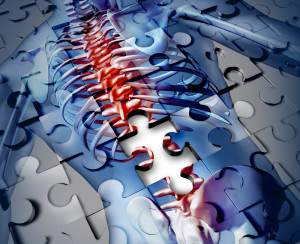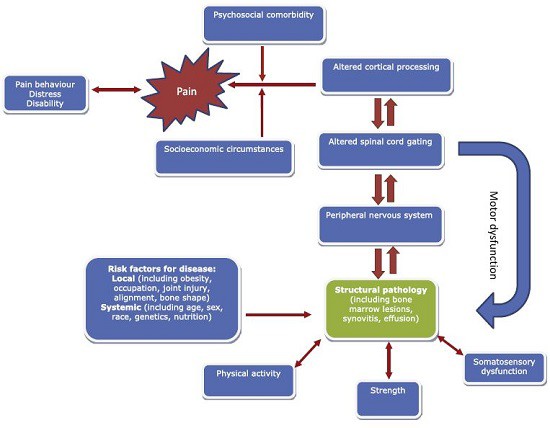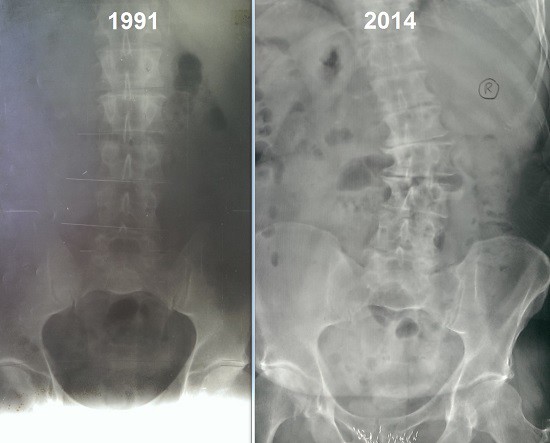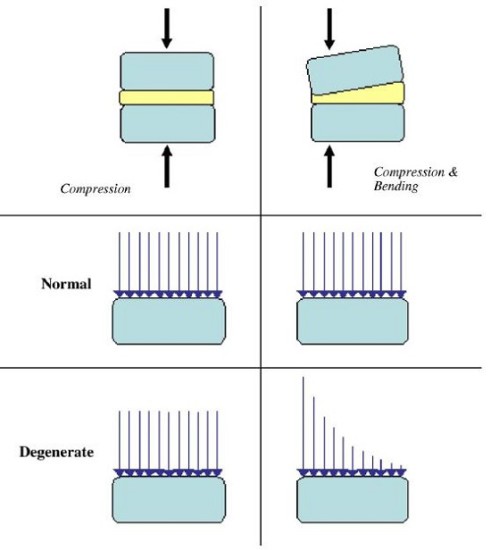 Degeneration of the spine is a prevalent problem that generally advances with age, though is not always restricted to the elderly1.
Degeneration of the spine is a prevalent problem that generally advances with age, though is not always restricted to the elderly1.
The presence of osteoarthritis is not always consistent with pain either. While progressive joint failure may cause pain and disability, approximately 50% of people with osteoarthritic changes don’t have any symptoms2. This is known as the “structure-symptom discord”.
How the spine degenerates and how pain is experienced is multifactorial. Firstly, osteoarthritis begins when there is an imbalance of mechanical load that exceeds the limit of what joint tissues can handle. Bony changes and inflammation cause dysfunction and instability of the joints. Secondly, changes to the nervous system occur around the spine, then spinal cord, and finally brain. How people move starts to change; muscle strength changes; and finally sensory awareness of their body changes. When these systems break down, the person experiences persistent pain (Fig. 1).

Figure 1. Biospsychosocial model depicting the relation of structural pathology to the experience of pain
How such dramatic alterations in shape of the spine occur over time (Fig. 2) is primarily due to a decrease in nutrition to the discs between the vertebrae3. The primary source of nutrition for the intervertebral discs are the end plates of the vertebrae. As degeneration progresses, fissures, cracks, clefts and fractures occur in the end plates, resulting in them thinning and water volume being lost from within the disc. This reduces disc height, misaligning mechanical forces and changing the shape of the spine (Fig. 3). As a consequence, more stress and strain is placed on the joints of the spine creating back pain. Long term pain can lead to more permanent, dysfunctional changes in the central nervous system ?

Figure 2. Spinewave case example of degeneration of the lumbar spine over 23 years resulting in scoliosis to the right and persistent low back pain

Figure 3. Qualitative stress distribution across vertebral end plate for normal and degenerated intervertebral disc under pure compressive and eccentric compressive loading
As a person with degeneration of the spine and osteoarthritis in many of my joints, I have spent many years looking for ways to decrease the pain levels I experience.
A replacement hip in 2012 went a long way to reducing pain in my back and hip but the degeneration in my spine still caused considerable pain from time to time, particularly in my lower back and neck.
Late in 2014 the pain in my neck was almost constant and increasing in intensity. I was taking diclofenac and other pain killers regularly. I was feeling very tired, stressed and looking for a different approach.
A friend suggested I try Spinewave. I was at the stage I was prepared to give anything a go.
Neil at Spinewave examined me and commissioned x-rays of my spine. Neil made it clear from the start that there was no cure for the degeneration in my spine and osteoarthritis in my joints. He assured me though, that the impact of this on my life could be improved. Neil made it clear it wouldn’t happen overnight – and it didn’t.
To begin with I saw Neil regularly for treatment sessions. A year on I am pain free most days. My neck has shown the greatest improvement and I now have much greater mobility. I recently painted my bathroom with a roller on an extended pole to do the ceiling. My neck was bent right back whilst doing this and did not give me one bit of bother. This wouldn’t have been possible a year ago.
Spinewave Wellness Centre has worked tirelessly to find ways to improve the quality of my life by increasing the fluidity and mobility of my joints. This has resulted in almost being pain free and continuing to do the things I enjoy.
Wendy
References:
- Niosi, C.A., Degenerative mechanics of the lumbar spine. The Spine Journal, 2004. 202S-208S.
- Hannan, M.T., et al., Analysis of the discordance between radiographic changes and knee pain in osteoarthritis of the knee. J Rheumatol, 2000. 27(6): 1513e7.
- Buckwalter, J.A., Aging and degeneration of the human intervertebral disc. Spine, 1995. 20(11): 1307–14.
